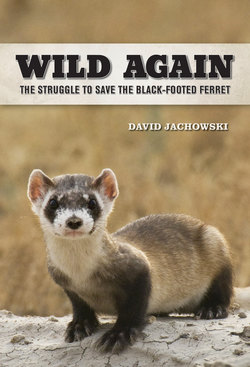Читать книгу Wild Again - David S. Jachowski - Страница 6
На сайте Литреса книга снята с продажи.
ОглавлениеPrologue
For better or worse, this is a book about black-footed ferret conservation that was written for everyone. It is not intended to be a comprehensive, technical review of every aspect of efforts to recover the black-footed ferret from the brink of extinction, something a scholar would buy for their bookshelf but rarely use. This book is meant to be taken from the shelf to engage you, to be passed on, bent, folded and dog-eared. Take it on that next road trip to the Great Plains. Open it at a campground in Badlands National Park. Take it to the U.S.–Mexican border and crack the spine while sitting on the Chihuahua grasslands, allowing grains of prairie dust to sneak between the pages, pages that will be stained with coffee cup marks after late nights of searching for badgers, swift foxes, and perhaps even black-footed ferrets.
As a consequence, this book does not contain all viewpoints on all issues related to black-footed ferret recovery. This is a personal book of stories told from personal experiences and perspectives that collectively, and hopefully, reflect the core conservation message for this species. It is a summary of the lengths that individuals and society are willing to go to preserve an endangered species—not just any endangered species, but one that was once considered extinct, then rediscovered, and later extirpated from the wild. At its population low it was, at the very least, one of the rarest carnivores, and likely the rarest species, in existence.
The story of ferret recovery is an engaging one, perhaps one of the more remarkable conservation stories in the United States. There is no need for fiction or hyperbole in discussing the events related to the years of active ferret conservation. Their plight simply grabbed me from a young age and pulled me into a part of the world that I never thought I would learn to love, or for which I would live to fight so dearly.
For every walk of life, there is a message to be learned that helps describe where you are from. It is what makes a place special, what defines your values, what you take pride in. When traveling overseas, one learns there are few greater American icons that grip people like the “Wild West.” And contrary to modern tourist propaganda, the Wild West is not in California, or the Rocky Mountains, or the bottom of the Grand Canyon, but in the center of the country—in the vastness of the Great Plains.
On the Great Plains, grasses dominate the landscape. And on those grasslands, patches of prairie dogs bring the prairie alive in increased plant and animal diversity. And on some of those prairie dog colonies, the presence of black-footed ferrets best symbolizes a healthy, biodiverse piece of ground—a locality likely complete with badgers, swift foxes, burrowing owls, mountain plovers, and ferruginous hawks, some of the prototypical representatives of the prairie.
Over the past thirty years, black-footed ferret rediscovery and subsequent conservation have marked a pivotal time in the history of the western United States. During this time new species were no longer being discovered at a rapid pace and attention turned more toward conservation. Species became protected by law through the Endangered Species Act, and the field of conservation biology was born. Ecosystem restoration was initiated on a scale whereby humans began to try to re-create even the image of the wild, formally restoring highly managed populations of large carnivores through efforts such as the Yellowstone Wolf Project.
This was also a period of time prior to which there were only rudimentary forms of the Internet and cell phones, so there was no spontaneous way to contact the outside world or be contacted. No global positioning units to provide directions; only paper maps, a compass, and memory. It was a time when you still could get lost in relatively unexplored corners of the West, imagining that if you veered just a little off the trail you would step on a patch of dirt where no human had previously placed a meandering foot. The view around the corner on a hiking trail was visible to you only as a reward for your efforts, and not to millions of people simultaneously through real-time satellite imagery, Google Earth, or a strategically placed solar-powered webcam.
Now, after spending a large portion of my life traveling in remote parts of the Great Plains, when I find a prairie dog town without black-footed ferrets it is hard not to think about what used to be or perhaps could be again. Similar to the finest pieces of art in a museum, to me, ferrets are that rare piece of the ecosystem puzzle that not only makes the prairie more noteworthy, but more complex and beautiful. Not only because ferrets are a unique trademark of the plains, but also because they represent a long history of struggle to save them from extinction and restore them to their prairie home. It is this past that makes any patch of land a ferret now occupies a little more memorable and special, for that land has regained a sense of being more complete and wild, a wildness that existed before, and can exist now only with gentle human intervention.
In this way, black-footed ferrets represent the wild heart of the Great Plains in an increasingly modern and civilized age. The question that remains unanswered is whether people will tolerate ferrets and their prey and allow them to recover—whether society increasingly finds value in reviving and rewilding the Great Plains.
